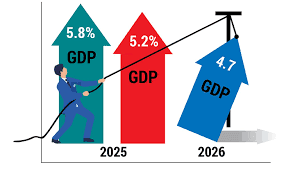Cambodia’s economic outlook has taken a sharp hit. Both the World Bank and the ASEAN+3 Macroeconomic Research Office (AMRO) recently downgraded the country’s 2025 GDP growth forecast. Rising U.S. tariffs and regional trade strains have placed new pressure on one of Southeast Asia’s most export-reliant economies.
The World Bank’s Cambodia GDP Forecast Downgrade in 2025 forecast from 5.5% to 4.0%, citing weakening external demand, policy uncertainty, and financial risks from high non-performing loans. Meanwhile, AMRO revised its growth outlook from 6.0% to 5.2%, underscoring the depth of challenges facing Cambodia’s economy.

Tariffs Weigh Heavily on Exports
The biggest drag on growth comes from trade with the U.S., Cambodia’s largest export market. In July 2025, Washington imposed a 36% tariff on Cambodian goods, down from a proposed 49%. Even at this lower rate, it remains among the steepest in the region.
The impact is significant. Cambodia exported nearly $9.9 billion worth of garments, footwear, and travel goods to the U.S. in 2024, representing about 38% of total exports. With the new tariffs, these industries face declining orders, thinner margins, and a potential loss of competitiveness.
The garment sector alone employs around 800,000 Cambodians and supports millions more indirectly. Tariff shocks threaten not just corporate profits but household incomes, job security, and worker protections.
Regional Trade Strains Add Pressure on Cambodia GDP Forecast Downgrade
Beyond U.S. measures, Cambodia faces broader headwinds across the ASEAN+3 region. Trade tensions, slowing global demand, and financial uncertainty have reduced investor confidence. AMRO highlighted these risks as central to its downgrade to 5.2% growth in 2025.
Cambodia’s heavy dependence on exports — which account for more than 40% of GDP — leaves the economy exposed. Any disruptions in global demand quickly filter into domestic output, employment, and fiscal stability.
Cambodia GDP Forecast Downgrade: Policy Adjustments and Responses
Despite these setbacks, Cambodia has taken steps to reduce trade distortions. In July 2025, the government lowered its own tariff rate from 49% to 36%. This move is expected to stimulate competition, ease costs for downstream industries, and encourage greater economic diversification.
Policy experts argue that diversification is critical. Cambodia needs to expand into new export markets and develop sectors such as agribusiness, tourism, and renewable energy to reduce reliance on the U.S. garment trade.
Economic Vulnerabilities Remain
The downgrade underscores Cambodia’s broader vulnerabilities. External shocks, whether from tariffs or global downturns, have outsized effects because of the narrow export base.
At the same time, financial risks are mounting. The World Bank has flagged concerns about rising non-performing loans, which could create pressure in the banking sector if businesses and households struggle under weaker economic conditions.
Cambodia GDP Forecast Downgrade: A Difficult Road Ahead
Cambodia’s 2025 outlook is far less optimistic than in previous years. Instead of robust expansion, the economy must now navigate trade shocks, regional uncertainty, and internal financial strains.
While the forecasted 5.2% growth is still positive, it represents a step back from earlier projections of 6% or higher. Policymakers face a critical challenge: balancing short-term stabilization with long-term reforms to build resilience and competitiveness.
Strategic Planning for Businesses in Cambodia
In such a climate, companies must rethink their strategies. At Market Research Cambodia, we bring over 40 years of experience in helping businesses adapt to shifting environments.
Strategic Planning Matters Because:
Alignment with National Development Goals: Ensures your operations support Cambodia’s diversification agenda.
Competitive Advantage: Helps you stand out in a crowded and uncertain market.
Risk Mitigation: Identifies and manages threats like tariff shocks or regulatory shifts.
Resource Optimization: Maximizes impact while minimizing waste in resource use.
With our tailored Strategic Planning services in Cambodia, we help businesses design robust strategies that not only address risks but also unlock new growth opportunities in a changing economy.
